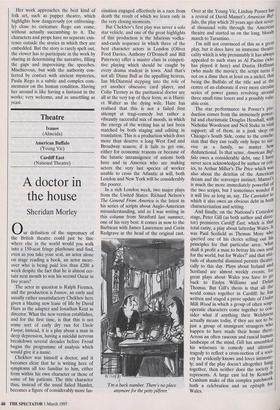Exhibitions
Paula Rego (Tate Gallery Liverpool, till 13 April)
On the rise
Andrew Lambirth
Paula Rego (born Lisbon 1935) is very hot property. A much-acclaimed painter, her work is owned in bulk by Charles Saatchi, is prominently featured in the best public collections here and abroad, and is currently being shown in a major retrospec- tive at the Tate Gallery, Liverpool. Rego is a figurative painter of considerable power, seemingly able to reinvent herself without putting a foot wrong. The show surveys the period 1959 to 1995 and separates into dis- tinct periods and styles. This is a substan- tial exhibition, offering a great deal to absorb and react to.
Some of the most impressive pictures are large recent pastels. Rego has gone on record saying that using pastel for her is bodily, sexually thrilling, in the same way as cutting up drawings to make her early col- lages was. It is thus fascinating to observe that in the pastels and collages Rego is at her most painterly. In so much of the other work, however potent the imagery, Rego operates as an illustrator rather than as an artist particularly interested in the plastic qualities and physical potential of paint. (She has often used acrylic in a starkly flat and unappealing way.) She is primarily an image-maker rather than a painter. As a consequence, most of her work looks very good in reproduction, which has made it correspondingly more widely accessible. There is no challenging avant-garde artistic component to her work. The challenge comes in terms of the subject matter, which is subversive, provocative, often shocking. But it is mediated to the audience through the literary device of the fairy tale or fable, which provides it with a nice stock of ambi- guity, and allows the audience to remain at a distance. The English are at home with this kind of story-telling, even if its sexual content is often uncomfortable.
For instance, Rego deals explicitly with the dark side of consanguinity. The paint- ing simply entitled 'The Family' is Rego's version of the raising of Lazarus and shows the girls prepared to do anything to resur- rect their father, even to warm him alive with their own sexual heat. In the painting `Caritas', does charity extend to the grant- ing of sexual favours? Several of the draw- ings for 'The Artist in her Studio' feature a woman and donkey apparently in congress. Is this the artist wrestling with her inspira- tion? Talking about the way she portrays women as dogs, Rego has said unequivo- cally: 'Animals are noble creatures. If women achieve the status of animals they are lucky.'
For the first time a substantial number of Rego's drawings are on show, with the last room of the exhibition being given over exclusively to works in pencil, watercolour, ink and wash. Rego draws swiftly and flu- ently both from life and from the imagina- tion. She has a fine touch, but the beautiful dot and line ink drawings, with or without wash, are in a class of their own.
The Dance' (1988) by Paula Rego
Her work approaches the best kind of folk art, such as puppet theatre, which highlights how dangerously (or enlivening- ly) close to caricature Rego can come, without actually succumbing to it. The characters and props have no separate exis- tence outside the stories in which they are embedded. But the story is rarely spelt out, the viewer has to participate in the work by sharing in determining the narrative, filling the gaps and improvising the speeches. Mischievous, but with the authority con- ferred by contact with ancient mysteries, Paula Rego is a subtle and complex com- mentator on the human condition. Having her around is like having a fantasist in the works; very welcome, and as unsettling as yeast.



























































 Previous page
Previous page